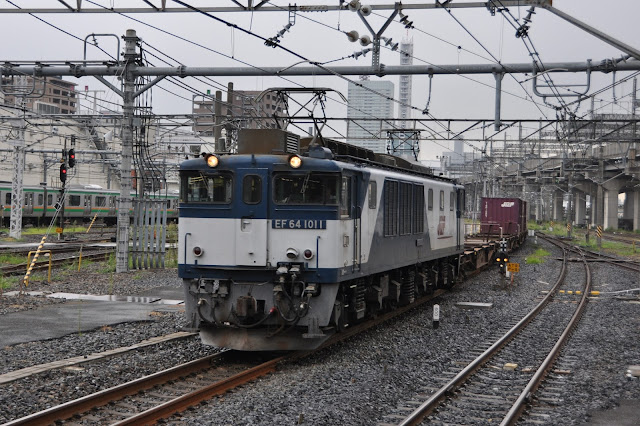 |
A JNR EF64-1000 heads north through Omiya with an intermodal train. The weather was far from ideal but the interesting narrow-gauge Bo-Bo-Bo locomotive more than made up for it.
|
Japan is famous for its railways. As soon as one thinks of railways in Japan attention almost immediately turns to the famous Shinkansen or 'Bullet Trains'- maybe that explains why after my trip to the country in 2013 I wrote an article about these quite soon after my return (you can
read it here if you missed it). But there is so much more to Japan's railways than this ultra-modern high speed system. The country boasts almost 14,000 miles of railway, much of it built to 1067mm narrow gauge (or 'cape gauge'). As well as seven national JR operators there are many totally private railways running across the country- together they carry well in excess of 20 billion people each year.
With the exception of the last half-handful of 'Blue [sleeper] trains' and some excursions there is a dearth of locomotives on passenger trains. If you want to see some of the fascinating locomotives in Japan you really need to focus your attention on it's freight services. These however are not always easy to find among the busy and frequent commuter train services. While planning my trip I also discovered precious little information on the internet. I hope therefore that if you are planning a trip to Japan and want to spend a little time indulging in its railways (as plenty of Japanese do) you might find this guide useful.
Urawa-
 |
Kawasaki built EF64 1016 heads north through Urawa. Many stations are full
of so much clutter that good photographs are almost impossible! Many
commuter lines also pass through providing entertainment between freights. |
Six tracks pass through this station which is in the North of Tokyo on the Tohoku line out of Ueno station. I had high hopes of seeing some freight here in the pleasant evening light- in reality in the space of 90 minutes I only saw two trains- and only one of them while I was in position. Freight appears to use the outer lines for which the sun is on the 'wrong' side for northbound trains. The situation is further complicated by Japan's tendency for very untidy overhead wires with a huge number of poles and obstructions to get in the way! Either I achieved a photograph I am pleased with of a container train with a Bo-Bo-Bo class EF64 on a container train. Of course between the freights there are commuter EMU's ever few minutes as well as a good selection of somewhat more interesting 'Limited Express' units to be seen at this location.
Nishi-Kokubunji-
 |
There is a clear view looking north from Nishi-Kokubunji.
This train with a pair of EF65's and the first production class
EH200 received plenty of local attention. |
Tokyo's main freight artery is the looping Musashino Line- unfortunately for the photographer much of it's route is underground and other large sections do not have a passenger service making it difficult to access. To the West of Tokyo the line crosses the Chuo Main Line at the station of Nishi-Kokubunji, usefully this is a section of the Musashino line with both a passenger service and an above ground station with reasonable views in both directions. I initially started on the lower level platforms of the Chuo Main Line (which I also believe to see freight at this location) but after nothing but units quickly moved up to the high level platforms of the Musashino line. This was much more successful with three freights (all heading northbound) photographed in the next hour. Clearly something was significant about the first (which was triple headed) as many photographers were on the platform only to disappear after its passage. There was variety in the locomotives here and also a lot less clutter in the form of poles than other stations. Definitely worth a try.
 |
| Looking the other way from Nishi-Kokobunji with Kawasaki built EF66-120 hauling a short tank train. There is a good clear view without too many poles! |
Omiya-
 |
| Twin unit Toshiba built EH500-15 heads north through Omiya. |
The final location I visited was back on the Tohoku line further north than Urawa, where it is fair to say I was a little disappointed with freight volumes. Omiya however is a large bustling junction station- and perhaps importantly, north of the point where the Musashino, and several other lines join. Initially I had my doubts about the location- very busy with commuters and with the main building over the railway tracks. However at each end of the station there are reasonable areas of good daylight. The next question of course in such a large sprawling station was where best to stand- it was obvious that there were at least several lines where freight could run but it soon became apparent that the most used (at least on my visit) was the 'through' line between platforms 9 and 11. I positioned myself here and a variety of freights rolled past- finally I had found somewhere that really was 'busy'- unfortunately the weather had other ideas and after seven freight trains in the space of just 35 minutes I had to accept defeat to the weather.
 |
Another freight through Omiya- this time hauled by a modern
Kawasaki built EF210-150 |
These three locations are by no means the only places where freight is visible in Tokyo- nor do I claim that they are necessarily the best locations to visit- however they are at worst reasonable and do all definitely see some freight action. On a network which is so busy, and to a foreigner often confusing they certainly offer somewhere to start. If you are of to Japan- I hope you find this useful!







No comments:
Post a Comment